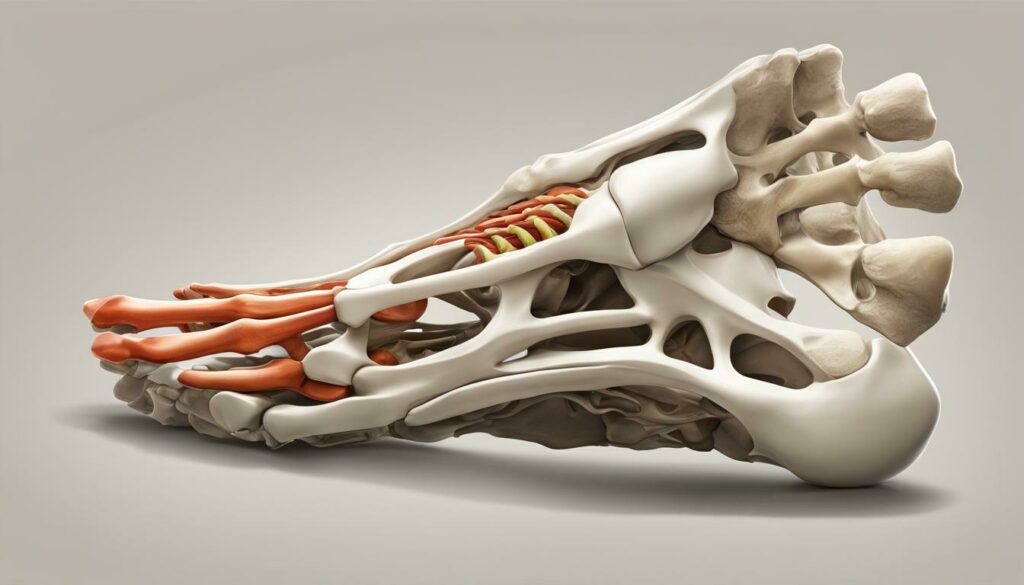
Have you ever wondered where the sesamoid bones are located in your foot? These small, pea-shaped bones are embedded within the tendons beneath the base of your big toe and help to facilitate movement in your foot. Understanding their location and function is crucial for maintaining proper foot anatomy and preventing injuries.
In this section, we will explore the location of the sesamoid bones and their significance in foot anatomy.
Key Takeaways:
- The sesamoid bones are located beneath the base of the big toe in the ball of the foot.
- They play a significant role in foot function and are responsible for absorbing shock and providing stability.
- Understanding the location and importance of these bones can help prevent injuries and maintain healthy foot anatomy.
Understanding Sesamoid Bone Location and Function
The sesamoid bones in the foot are two small, pea-shaped bones located beneath the first metatarsal bone, which connects to the big toe, and embedded in the tendons that run along the ball of the foot. They act as pulleys, helping to redirect and amplify the forces exerted on the tendons during movement and providing stability to the joint.
While sesamoids are found throughout the body, the two in the foot are the most commonly known. These bones vary in size and shape from person to person but are typically around one centimeter in length and a few millimeters thick at the center.
The sesamoid bones’ location is essential in providing the foot’s necessary support and aiding in proper movement and balance. They facilitate weight distribution and shock absorption while engaging in activities like running and jumping.
How Do Sesamoid Bones Function?
The two sesamoid bones work with the tendons to enable smooth movement during physical activity. For example, when you push off while running, the sesamoid bones help raise the big toe, allowing the foot to gain leverage to push off the ground with greater force. They help protect the tendons and act as a shield against the pressure placed on the ball of the foot.
Sesamoid bones’ small size and location make them vulnerable to injury, leading to pain and discomfort in the foot. As a result, understanding how they function is crucial in addressing any issues that arise.
Sesamoid Bone Injuries: Causes and Symptoms
Sesamoid bone injuries in the foot are common and can cause significant amounts of pain and discomfort. The two sesamoid bones located in the ball of the foot can become inflamed or fractured due to a variety of reasons.
One of the most common causes of sesamoid bone injuries is overuse, particularly among athletes who put significant stress on their feet. Activities like running, jumping, and dancing can cause small fractures or irritate the surrounding tissue.
Sesamoiditis is a condition that arises from inflammation of the sesamoid bones and can cause pain and tenderness in the ball of the foot. It can be caused by repetitive pressure and strain or by a sudden injury.
In addition to overuse, sesamoid bone injuries can also occur due to trauma, such as a fall or direct blow to the foot. High-heeled shoes can also put excessive pressure on the sesamoid bones, leading to pain and discomfort.
Common symptoms of sesamoid bone injuries include pain, swelling, and difficulty bearing weight on the affected foot. Sesamoiditis can also cause a dull ache or burning sensation in the ball of the foot.
If you experience any of these symptoms, it is important to seek medical attention to prevent further damage and complications.
Managing Sesamoid Bone Injuries and Foot Pain
If you are experiencing foot pain or suspect a sesamoid bone injury, it is crucial to seek medical attention promptly. Ignoring the discomfort or continuing to put pressure on the affected area can lead to further damage and prolong your recovery time.
Treatment for sesamoid bone injuries typically involves a combination of rest, ice, and physical therapy. Your doctor may also recommend over-the-counter pain relief medication or prescribe stronger medication if necessary.
Rest is essential for allowing the injured area to heal properly. You may need to wear a brace or a cast to immobilize the foot and reduce pressure on the sesamoid bones. In some cases, crutches may be necessary to keep weight off the affected foot while it heals.
Ice can help reduce swelling and pain. Apply an ice pack to the affected area for 15-20 minutes several times a day. Be sure to wrap the ice pack in a thin cloth or towel to prevent skin irritation or damage.
Physical therapy may be recommended to help restore flexibility and strength to the affected foot. This may involve exercises, stretches, or massage. Your physical therapist can also provide guidance on proper footwear and foot care to prevent further injury.
In more severe cases, surgical intervention may be necessary. This may involve removing the damaged sesamoid bone or realigning the foot to reduce pressure on the affected area. Your doctor can discuss the options with you and help determine the best course of action.
Remember, early intervention and proper treatment are key to managing sesamoid bone injuries and foot pain. With proper care and attention, you can reduce your pain and improve your foot function, allowing you to get back on your feet and enjoy your daily activities.
Conclusion
In conclusion, the sesamoid bones in the foot play an important role in foot function and are located in the ball of the foot. Any injuries or pain in this area can be caused by a variety of factors, including overuse, trauma, or conditions like sesamoiditis.
It is essential to seek medical attention if you experience persistent foot pain or suspect a sesamoid bone injury. Treatment options may include rest, ice, physical therapy, or even surgery in severe cases.
Remember, taking care of your feet is crucial to maintaining overall health and wellbeing. Pay attention to any changes or discomfort in the ball of your foot, and don’t hesitate to consult a medical professional for advice and treatment.
FAQ
Q: Where are the sesamoid bones located in the foot?
A: The sesamoid bones are located in the ball of the foot, just beneath the big toe joint.
Q: What is the function of sesamoid bones in the foot?
A: Sesamoid bones provide support and act as a pulley for the tendons in the foot. They help to distribute weight and provide stability during walking and running.
Q: What causes sesamoid bone injuries?
A: Sesamoid bone injuries can be caused by repetitive stress, trauma, or excessive pressure on the foot. Activities such as dancing, playing sports, or wearing high heels can increase the risk of sesamoid bone injuries.
Q: What are the symptoms of sesamoid bone injuries?
A: Symptoms of sesamoid bone injuries may include pain in the ball of the foot, swelling, difficulty walking or bending the big toe, and bruising.
Q: How are sesamoid bone injuries and foot pain managed?
A: Treatment options for sesamoid bone injuries and foot pain include rest, ice, wearing proper footwear, using orthotic inserts, physical therapy, and in some cases, surgery.
Q: What is sesamoiditis?
A: Sesamoiditis is a condition characterized by inflammation of the sesamoid bones and the surrounding tissues. It is often caused by overuse and can result in pain and difficulty walking.
Q: Are sesamoid bone injuries common?
A: Sesamoid bone injuries are relatively common, especially among athletes and individuals who engage in activities that put strain on the feet.
Q: Can sesamoid bone injuries be prevented?
A: While it is not always possible to prevent sesamoid bone injuries, wearing proper footwear, gradually increasing activity levels, and taking regular breaks during high-impact activities can help reduce the risk.
